Abstract
Even though there exists no universal definition, in the South America Andean Region, extreme precipitation events can be referred to the period of time in which standard thresholds of precipitation are abruptly exceeded. Therefore, their timely forecasting is of great interest for decision makers from many fields, such as: urban planning entities, water researchers and in general, climate related institutions. In this paper, a data-driven study is performed to classify and anticipate extreme precipitation events through hydroclimate features. Since the analysis of precipitation-events-related time series involves complex patterns, input data requires undergoing both pre-processing steps and feature selection methods, in order to achieve a high performance at the data classification stage itself. In this sense, in this study, both individual Principal Component Analysis (PCA) and Regresional Relief (RR) as well as a cascade approach mixing both are considered. Subsequently, the classification is performed by a Support-Vector-Machine-based classifier (SVM). Results reflect the suitability of an approach involving feature selection and classification for precipitation events detection purposes. A remarkable result is the fact that a reduced dataset obtained by applying RR mixed with PCA discriminates better than RR alone but does not significantly hence the SVM rate at two- and three-class problems as done by PCA itself.
D.H. Peluffo-Ordóñez—This work is supported by SDAS Research Group, EPMAPS and Yachay Tech University.
Access this chapter
Tax calculation will be finalised at checkout
Purchases are for personal use only
Similar content being viewed by others
References
McGuffie, K., Henderson-Sellers, A.: Forty years of numerical climate modelling. Int. J. Climatol. J. R. Meteorol. Soc. 21(9), 1067–1109 (2001)
Lynch, P.: The origins of computer weather prediction and climate modeling. J. Comput. Phys. 227(7), 3431–3444 (2008)
Bauer, P., Thorpe, A., Brunet, G.: The quiet revolution of numerical weather prediction. Nature 525(7567), 47–55 (2015)
Jordan, M.I., Mitchell, T.M.: Machine learning: trends, perspectives, and prospects. Science 349(6245), 255–260 (2015)
Ganguly, A.R., et al.: Data-driven solutions. Climate 2020: Degrees of Devastation, pp. 82–85 (2018)
Maqsood, I., Khan, M.R., Abraham, A.: An ensemble of neural networks for weather forecasting. Neural Comput. Appl. 13(2), 112–122 (2004). https://doi.org/10.1007/s00521-004-0413-4
Radhika, Y., Shashi, M.: Atmospheric temperature prediction using support vector machines. Int. J. Comput. Theor. Eng. 1(1), 55 (2009)
Xingjian, S.H.I., Chen, Z., Wang, H., Yeung, D.Y., Wong, W.K., Woo, W.C.: Convolutional LSTM network: a machine learning approach for precipitation nowcasting. In: Advances in Neural Information Processing Systems, pp. 802–810 (2015)
Mehrkanoon, S.: Deep shared representation learning for weather elements forecasting. Knowl.-Based Syst. 179, 120–128 (2019)
McKinney, W.: Data structures for statistical computing in python. In: van der Walt, S., Millman, J. (eds.) Proceedings of the 9th Python in Science Conference, pp. 56–61 (2010)
Pedregosa, F., et al.: Scikit-learn: Machine learning in Python. J. Mach. Learn. Res. 12, 2825–2830 (2011)
Team, R.C.: R: a language and environment for statistical computing. R Foundation for Statistical Computing, Vienna, Austria (2014)
EPMAPS-FONAG. Estación Científica Agua y Páramo. http://www.fonag.org.ec/web/estacion-cientifica-agua-y-paramos/
EPMAPS. Empresa Pública Metropolitana de Agua Potable Y Saneamiento. https://www.aguaquito.gob.ec/
Echavarria, M.: Financing watershed conservation: the Fonag water fund in Quito, Ecuador. In: Selling Forest Environmental Services, pp. 105–115. Routledge (2012)
Peluffo Ordoñez, D.H., Lee, J.A., Verleysen, M., Rodriguez, J.L., Castellanos-Dominguez, G.: Unsupervised relevance analysis for feature extraction and selection. a distance-based approach for feature relevance. In: 3rd International Conference on Pattern Recognition Applications and Methods (ICPRAM 2014) (2015)
Robnik-Šikonja, M., Kononenko, I.: Theoretical and empirical analysis of Relieff and RRelieff. Mach. Learn. 53(1–2), 23–69 (2003). https://doi.org/10.1023/A:1025667309714
Cortes, C., Vapnik, V.: Support-vector networks. Mach. Learn. 20(3), 273–297 (1995). https://doi.org/10.1007/BF00994018
Kotsiantis, S.B., Zaharakis, I.D., Pintelas, P.E.: Machine learning: a review of classification and combining techniques. Artif. Intell. Rev. 26(3), 159–190 (2006). https://doi.org/10.1007/s10462-007-9052-3
Hsu, C.W., Chang, C.C., Lin, C.J., et al.: A practical guide to support vector classification (2003)
Chen, D.R., Wu, Q., Ying, Y., Zhou, D.X.: Support vector machine soft margin classifiers: error analysis. J. Mach. Learn. Res. 5, 1143–1175 (2004)
Hofmann, M.: Support vector machines-kernels and the kernel trick. Notes 26(3), (2006)
Acknowledgments
This work is supported by SDAS Research Group (www.sdas-group.com).
Author information
Authors and Affiliations
Corresponding author
Editor information
Editors and Affiliations
Rights and permissions
Copyright information
© 2020 Springer Nature Switzerland AG
About this paper
Cite this paper
González-Vergara, J., Escobar-González, D., Chaglla-Aguagallo, D., Peluffo-Ordóñez, D.H. (2020). A Data-Driven Approach for Automatic Classification of Extreme Precipitation Events: Preliminary Results. In: Florez, H., Misra, S. (eds) Applied Informatics. ICAI 2020. Communications in Computer and Information Science, vol 1277. Springer, Cham. https://doi.org/10.1007/978-3-030-61702-8_14
Download citation
DOI: https://doi.org/10.1007/978-3-030-61702-8_14
Published:
Publisher Name: Springer, Cham
Print ISBN: 978-3-030-61701-1
Online ISBN: 978-3-030-61702-8
eBook Packages: Computer ScienceComputer Science (R0)




